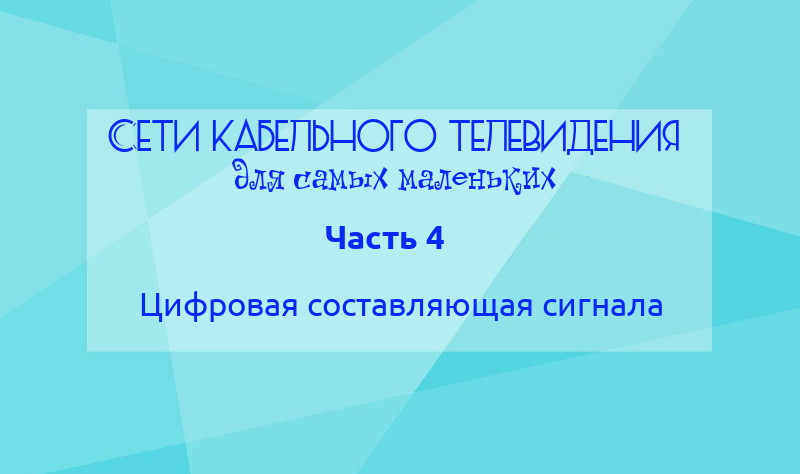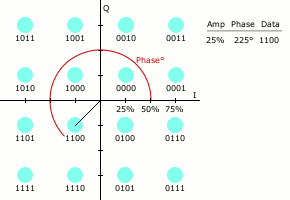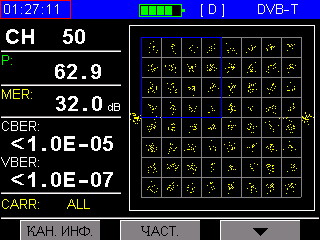Cable TV networks for the smallest. Part 4: Digital Signal

We all know very well that the world of technology around is digital, or is striving for this. Digital television broadcasting is far from news, however, if you were not specifically interested in this, your inherent technologies may be unexpected.
Content of a series of articles
Composition of a digital television signal
A digital television signal is a transport stream of different versions of MPEG (sometimes other codecs), transmitted by a radio signal using quadrature amplitude QAM modulation of varying degrees. Any signalman these words should be clear as day, so bring only SIFCO from Wikipedia , which I hope will give an understanding of what it is for those who simply have no interest:
UPD: In the comments, this picture is recognized as incorrect, but, nevertheless, she is very visible. Therefore, I will leave it for those who do not know anything about modulation and do not really want to go deep, but want to understand what kind of points we are discussing here.

Such modulation in one form or another is used not only for “teleachronachism”, but also for all those who are at the peak of technology for data transmission systems. The speed of the digital stream in the "antenna" cable is hundreds of megabits!
Digital Signal Parameters
Using the Deviser DS2400T device in the display mode of the digital signal parameters, we can see how it really happens:

Signals of three standards are present on our network: these are DVB-T, DVB-T2 and DVB-C. We will consider them in turn.
DVB-T
This standard did not become the main one in our country, giving way to the second version, however, it is quite suitable for use by the operator for the reason that DVB-T2 receivers are backward compatible with the first generation standard, which means that the subscriber can receive such a signal on almost any digital TV without additional consoles. In addition, the standard intended for transmission by air (the letter T stands for Terrestrial, ether) has such good noise immunity and redundancy that it sometimes works where, for some reason, the analog signal does not creep through.

On the instrument screen, we can observe how the constellation 64QAM is built (the standard supports QPSK, 16QAM, 64QAM). It can be seen that in real conditions the points do not add up to one, but come with some expansion. This is normal as long as the decoder can determine which square the arriving point belongs to, but even in the image above, you can see the areas where they are located on the border or close to it. Using this picture, you can quickly determine the signal quality “by eye”: if the amplifier works poorly, for example, the points are randomly arranged, and the TV cannot collect a picture from the received data: “pixel”, or even completely freeze. There are times when the amplifier processor “forgets” to add one of the components (amplitude or phase) to the signal. In such cases, on the screen of the device you can see a circle or ring the size of the entire field.
On the left side of the screen, under the channel number, we see quantitative parameters:
Signal level ( P ) in the same dBµV as for the analogue, however, for a digital signal, GOST regulates only 50 dBµV at the input to the receiver. That is, in areas with greater attenuation, the “digit” will work better than the analogue.
The value of modulation errors ( MER ) shows how distorted the signal we receive, that is, how far the arriving point can be from the center of the square. This parameter is similar to the signal-to-noise ratio from an analog system, the normal value for 64QAM is from 28dB. Here it is clearly seen that significant deviations in the above image correspond to quality above the norm: this is the noise immunity of the digital signal.
The number of errors in the received signal ( CBER ) - the number of errors in the signal before processing any correction algorithms.
The number of errors after the Viterbi decoder ( VBER ) is the result of a decoder that uses redundant information to recover errors in the signal. Both of these parameters are measured in "pieces per quantity received." In order for the device to show the number of errors of less than one in one hundred thousand or ten million (as in the above image), it needs to receive these ten million bits, which takes some time on one channel, so the measurement result does not appear immediately, and may even be bad at first (E -03, for example), but after a couple of seconds, go to an excellent parameter.
DVB-T2
The digital broadcasting standard adopted in Russia can also be transmitted by cable. At first glance, the shape of the constellation may surprise you a bit:

Such a rotation additionally increases noise immunity, since the receiver knows that the constellation must be rotated by a given angle, so you can filter what comes without a fixed shift. It can be seen that for this standard, the norms of bit errors are an order of magnitude higher and the errors in the signal before processing no longer go beyond the measurement limit, but are quite real 8.6 per million. To correct them, the LDPC decoder is used , so the parameter is called LBER.
Due to the increased noise immunity, this standard supports the 256QAM modulation level, but only 64QAM is currently used in broadcasting.
DVB-C
This standard was originally created for transmission via cable (C - Cable) - the environment is much more stable than air, therefore it allows you to use a higher degree of modulation than DVB-T, and therefore transmit a larger amount of information without using complex coding.

Here we see the constellation 256QAM. Squares became larger, their size became smaller. The probability of error has increased, which means that to transmit such a signal, a more reliable environment is needed (or more complex coding, as in DVB-T2). Such a signal can “scatter” where the analogue and DVB-T / T2 work, but it also has a noise immunity margin and error correction algorithms.
Due to the higher probability of error, the MER parameter for 256-QAM is normalized to 32 dB.
The error bit counter has risen an order of magnitude and is already calculating one error bit per billion, but even if there are hundreds of millions (PRE-BER ~ E-07-8), the Reed-Solomon decoder used in this standard will eliminate all errors.
